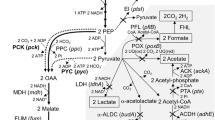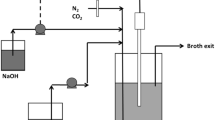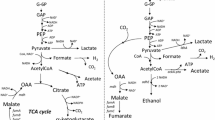We examined succinic acid production in Escherichia coli AFP111 using dual-phase fermentations, which comprise an initial aerobic growth phase followed by an anaerobic production phase. AFP111 has mutations in the pfl, ldhA, and ptsG genes, and we additionally transformed this strain with the pyc gene (AFP111/pTrc99A-pyc) to provide metabolic flexibility at the pyruvate node. Aerobic fermentations with these two strains were completed to catalog physiological states during aerobic growth that might influence succinate generation in the anaerobic phase. Activities of six key enzymes were also determined for these aerobic fermentations. From these results, six transition times based on physiological states were selected for studying dual-phase fermentations. The final succinate yield and productivity depend greatly on the physiological state of the cells at the time of transition. Using the best transition time, fermentations achieved a final succinic acid concentration of 99.2 g/l with an overall yield of 110% and productivity of 1.3 g/l h. Journal of Industrial Microbiology & Biotechnology (2002) 28, 325–332 DOI: 10.1038/sj/jim/7000250
Similar content being viewed by others
Author information
Authors and Affiliations
Additional information
Received 01 October 2001/ Accepted in revised form 12 March 2002
Rights and permissions
About this article
Cite this article
Vemuri, G., Eiteman, M. & Altman, E. Succinate production in dual-phase Escherichia coli fermentations depends on the time of transition from aerobic to anaerobic conditions. J Ind Microbiol Biotech 28, 325–332 (2002). https://doi.org/10.1038/sj/jim/7000250
Issue Date:
DOI: https://doi.org/10.1038/sj/jim/7000250




